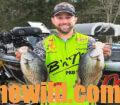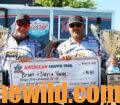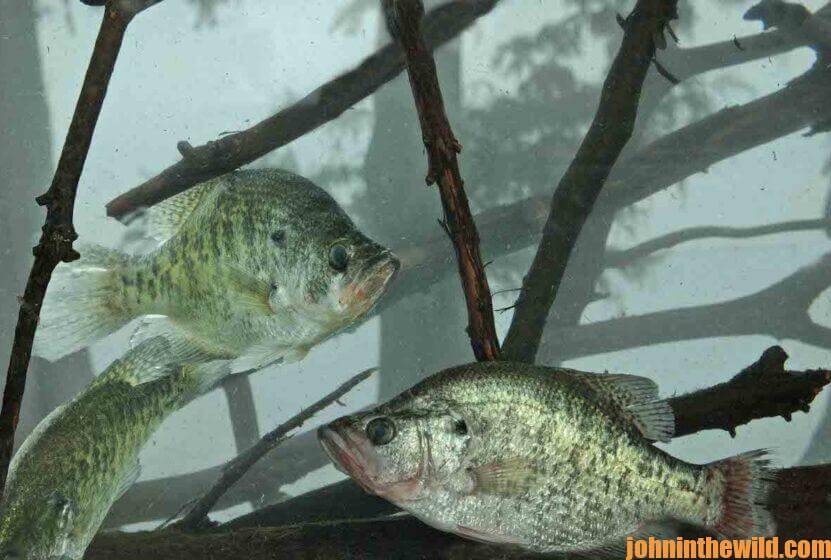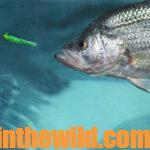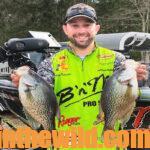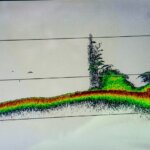Editor’s Note: Jordan Newsome of Iron Station, North Carolina, has crappie tournament fished for eight years but has been crappie fishing since he was a child. He fishes the Crappie USA Tournament Circuit (https://www.crappieusa.com/), the Central Carolina Crappie Trail
(https://www.crappie.com/crappie/north-carolina/423350-central-carolina-crappie-trail), the Yadkin River Crappie Trail (https://www.facebook.com/yadkinrivercrappietrail) and the Fish the Carolinas Crappie Trail (https://www.fishthecarolinas.org/). Newsome has become an expert on using the latest technology – the Garmin LiveScope – to catch crappie.
 In tournament crappie fishing, the winner’s determined by the angler or the team who catches the seven biggest crappie and brings them live to the tournament scales. So, I’m always trying to find and catch the biggest crappie – usually 1-1/2 – 2+ pounds – in the lakes where the tournaments are held. Most crappie tournaments will be won by what we call tournament crappie – seven crappie weighing from 1-2 pounds plus. LiveScope gives me the ability to determine just about how big a crappie is before I fish for it. Generally when I see a fish on my LiveScope, I can determine if it weighs at least 1-1/2 to 2 pounds or perhaps more than 2 pounds. Every tournament I fish is a catch-and-release tournament. We put back into the lake the big crappie that we weigh-in to win.
In tournament crappie fishing, the winner’s determined by the angler or the team who catches the seven biggest crappie and brings them live to the tournament scales. So, I’m always trying to find and catch the biggest crappie – usually 1-1/2 – 2+ pounds – in the lakes where the tournaments are held. Most crappie tournaments will be won by what we call tournament crappie – seven crappie weighing from 1-2 pounds plus. LiveScope gives me the ability to determine just about how big a crappie is before I fish for it. Generally when I see a fish on my LiveScope, I can determine if it weighs at least 1-1/2 to 2 pounds or perhaps more than 2 pounds. Every tournament I fish is a catch-and-release tournament. We put back into the lake the big crappie that we weigh-in to win.
John E. Phillips: Where do you find the biggest crappie in the lakes you fish?
Jordan Newsome: Generally year-around, we look for big crappie in the mouths of large creeks that feed into main river channels or the main lake. The mouths of creeks and the river channels seem to hold baitfish all year long, and wherever you pinpoint the bait, you’ll locate the crappie. In the spring and early fall, the crappie will move-up shallow, so we’ll fish all the way to the backs of the creeks. During the fall and winter, I’ll search for crappie in some of the biggest creeks on the northern ends of the lakes I’m fishing. I want to find the creeks furthest away from the dam at the upper end of each lake. I’ll also search for fish in the mouths of those creeks to start with before beginning to scan all the way to the backs of those creeks. However, typically, the biggest crappie will hold usually over deep water and suspend, letting the baitfish come to them. You often may find locate schools of baitfish and not crappie, but if you do identify crappie, they’ll be related to and feeding on baitfish. Big crappie don’t get far from their dinner tables.

If we pinpoint a group of crappie suspended in open water, the bigger crappie usually will be suspended by themselves away from smaller crappie. Big crappie will hold most of the time in an area for two to three weeks, as long as baitfish are there. Once the baitfish move, so will the big crappie. With LiveScope, I’ll often see big crappie right on or near the bottom of a lake. As they sense baitfish coming in, they’ll move higher in the water column – up to about 2-feet below the baitfish. Then they’ll attack the baitfish, eat what they want and – more than likely – move back down into deeper water.
I’ve learned that you may follow a big crappie for 10-15 minutes as it swims to different places. But once that fish stops and starts looking for bait, that’s when it becomes catchable. Although you have very-little chances of catching a big crappie that’s swimming around, your best opportunity of catching it is when it decides to stop in the water, suspend and wait for the baitfish to come to it. When a big crappie is moving, I try to stay 40-50 feet away from it, so I don’t spook the fish. However, often within two to three minutes, these big crappie may stop. Then I’ll get my boat in a position where I can make a cast and try to catch that one big crappie.
Phillips: How are you finding big crappie with the LiveScope?
Newsome: I’ll start off using 2D (down-scanning) sonar to locate schools of baitfish holding in a certain area. Then I’ll move to the front of the boat and use my LiveScope to pinpoint the biggest crappie in that region. I’ll sweep my transducer mounted on my trolling motor to the left and right of the front of my boat and all the way around my boat, until I spot a big crappie, I’ll get my boat in position to cast to that fish. If I see a small crappie, I’ll move on and keep looking. When fishing tournaments, I’m looking for a crappie weighing 1-1/2 to 2-pounds plus. If I spot a crappie that I know is 2 pounds+, I’ll definitely fish for that one. The grid on my LiveScope shows one-foot increments from the surface to the bottom. If I see a mark of a crappie that’s 2-feet tall or bigger, that’s when I know that that crappie, more than likely, weighs 2 pounds or more.
 Phillips: When you locate schools of baitfish in an area, how many different schools of crappie will you find trying to feed off those baitfish?
Phillips: When you locate schools of baitfish in an area, how many different schools of crappie will you find trying to feed off those baitfish?
Newsome: One of the things that LiveScope has shown me is that there’s many-more fish in the lakes I fish than I thought there were. I’ll see hundreds of crappie feeding on different schools of baitfish once I find the bait. But in a crappie school of about 100 fish, there only may be 15 tournament crappie (crappie that weigh 1-1/2 to 2+ pounds).
Phillips: When you locate a big school of crappie feeding on baitfish, and perhaps there are 15- big crappie in that school, how do you separate these big crappie from the other crappie in that school?
Newsome: Generally big crappie will be holding off to the side of a school of smaller crappie. So, you can pick them off. I’ve observed that if two little fish and one big fish are concentrating together, if I cast my bait out and spot a little fish going after it, I can pull my jig away and make another cast to the big crappie.
Phillips: Why do you think big crappie generally tend not to swim with smaller crappie?
 Newsome: I can’t give you a scientific reason. But here’s what I think. Perhaps the big crappie are older crappie. If fish are perhaps like people, when they go to a party for young people, they’re looking for something tasty to eat and a place to hang out with people their age. But if you see an older gentleman sitting on his front porch, he’s often waiting for somebody to bring him his food. Perhaps older crappie have learned they’re less likely to get caught or be eaten, if they stay to themselves. Also bigger crappie don’t have the same number of predator fish following them that smaller crappie do. Smaller crappie can be eaten by just about every fish that swims in a lake from the time they’re 1-inch long up until they weigh 1/2-pound or more. A really monstrous fish could eat a 1 to 1-1/2 pound crappie. Perhaps too the crappie that are 1 to 1-1/2 pounds or more that we catch in tournaments haven’t been caught and released by crappie fishermen. Those big crappie aren’t fooled as easily by minnows or jigs, and perhaps never have been caught before.
Newsome: I can’t give you a scientific reason. But here’s what I think. Perhaps the big crappie are older crappie. If fish are perhaps like people, when they go to a party for young people, they’re looking for something tasty to eat and a place to hang out with people their age. But if you see an older gentleman sitting on his front porch, he’s often waiting for somebody to bring him his food. Perhaps older crappie have learned they’re less likely to get caught or be eaten, if they stay to themselves. Also bigger crappie don’t have the same number of predator fish following them that smaller crappie do. Smaller crappie can be eaten by just about every fish that swims in a lake from the time they’re 1-inch long up until they weigh 1/2-pound or more. A really monstrous fish could eat a 1 to 1-1/2 pound crappie. Perhaps too the crappie that are 1 to 1-1/2 pounds or more that we catch in tournaments haven’t been caught and released by crappie fishermen. Those big crappie aren’t fooled as easily by minnows or jigs, and perhaps never have been caught before.
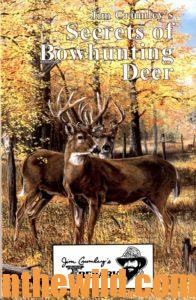 To learn more about crappie fishing, check out John E. Phillips’ book, “Crappie: The Year-Round River Fisherman’s Bible” at https://www.amazon.com, available in Kindle, print and Audible. At this writing, some states are still having deer seasons which run through February 10th and others last even longer. To learn more about hunting for deer, check out John E. Phillips’ “Jim Crumley’s Secrets of Bowhunting Deer”, now available as of January 1, 2022, in Audible, as well as paperback and Kindle at https://www.amazon.com. You may have to copy and paste this link into your browser. (When you click on the books, notice on the left where Amazon says you can read and hear 10% of the book for free). On the right side of the page and below the offer for a free Audible trial, you can click on Buy the Audible book.
To learn more about crappie fishing, check out John E. Phillips’ book, “Crappie: The Year-Round River Fisherman’s Bible” at https://www.amazon.com, available in Kindle, print and Audible. At this writing, some states are still having deer seasons which run through February 10th and others last even longer. To learn more about hunting for deer, check out John E. Phillips’ “Jim Crumley’s Secrets of Bowhunting Deer”, now available as of January 1, 2022, in Audible, as well as paperback and Kindle at https://www.amazon.com. You may have to copy and paste this link into your browser. (When you click on the books, notice on the left where Amazon says you can read and hear 10% of the book for free). On the right side of the page and below the offer for a free Audible trial, you can click on Buy the Audible book.
Tomorrow: How to Use the LiveScope to Know Crappie Weights

